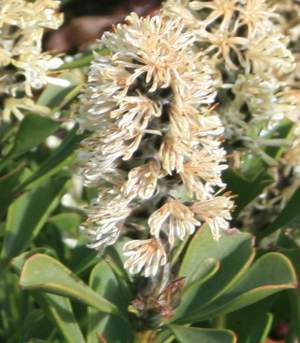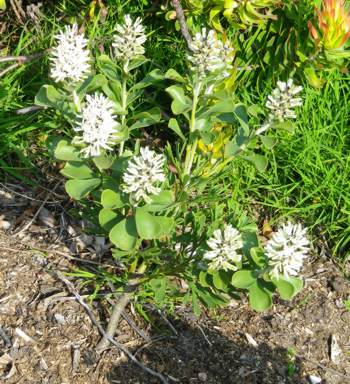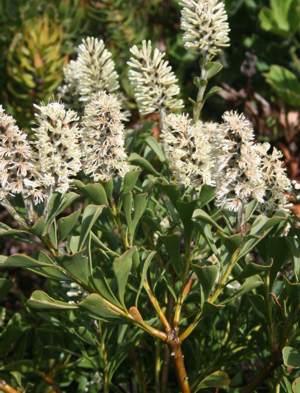Paranomus sceptrum-gustavianus
Paranomus sceptrum-gustavianus (Sparrm.)Hyl.
Family: Proteaceae
Common names: King Gustave's sceptre, bottlebrush, white sceptre, sceptre-like paranomus (Eng.); perdebos, septerpluimbos (Afr.)
Introduction
This is a favourite among the Paranomus with showy, sweetly scented flowers and attractive foliage.

Description
Description
Paranomus sceptrum-gustavianus is a stout, usually symmetrical, branched shrub which grows to a height of 1.8m. The leaves have two distinct forms and the transition from the divided to the entire form is gradual. Leaves have wedge-shaped bases, are hairless, 10-80mm long, spatula- to rhomboidally-shaped and the tips are rounded and leathery. The typical flower spike is 70 mm long. The flowers are grouped in fours, with each group of four carried beneath a leathery bract. The shell-like bracts remain on the plant for a year or longer, well after the seeds have dropped off. It flowers in winter to early summer from July to March and the flowers are strongly scented.

Conservation Status
Status
Paranomus sceptrum-gustavianus is Red-Listed as Near Threatened. Its wild population is declining due to invasion of alien plant species and unexplained post-fire mortality. Most of its wild populations are small and isolated and may be susceptible to extreme fluctuations, thus making it difficult to predict.
Distribution and habitat
Distribution description
Paranomus sceptrum-gustavianus is found overlooking the sea on the Hottentots Holland Mountains as well as those above Betty's Bay and Hangklip. Paranomus sceptrum-gustavianus also occurs on the Riviersonderend Mountains as well as near Caledon, Hermanus and Elim in the Bredasdorp area. On the Riviersonderend Mountains it flourishes at altitudes varying from 150-500 m. It is found mostly on south-facing, moist mid upper slopes.
Derivation of name and historical aspects
History
The genus was named by English botanist Richard Anthony Salisbury. The genus name is from the Greek para which means 'illegal' and nomus which means 'customs or law'. This is in reference to the leaves which are strikingly different from the normal plant pattern and the feature which must have impressed Salisbury. It was later renamed Nivenia by rival botanist Robert Brown to honour plant collector James Niven, but Salisbury's name has priority. Today the standard reference on the genus is its revision published in 1970 by Dr Margaret Levyns, and these notes are based mainly on her work.
The specific name refers to King Gustav III of Sweden and this plant was named in his honour by the Swedish Botanist Sparrman in 1777. See Paranomus reflexus for details.
Paranomus is a genus of 18 species; an unusual, small group of evergreen shrubs commonly known as sceptres in the Protea family. It is endemic to the Cape Floristic Region of South Africa. Essentially a montane genus, only a few members of Paranomus extended to sea-level and populations of the 18 species are scattered from Van Rhynsdorp to Port Elizabeth, with an area of maximum concentration covering the districts of Caledon, Worcester and Swellendam.
Ecology
Ecology
Paranomus sceptrum-gustavianus flowers are strongly sweet scented and are pollinated by insects.

Uses
Use
Paranomus sceptrum-gustavianus is popular for floral art purposes, the tall spikes lending unusual, subtle colour to arrangements.
Growing Paranomus sceptrum-gustavianus
Grow
Paranomus sceptrum-gustavianus is an easy to grow species and they are cultivated successfully in the Western Cape. It is drought tolerant once established and it can withstand frost, although young plants need to be protected. They grow well in a sunny position and in well-drained and acidic soil containing plenty of compost and peat to give good flowering performance. As with all Proteaceae, fertilisers should be avoided, as their (generally considered) normal levels of phosphorus can harm the plants. They have a specially adapted system of fine roots that will develop to seek out available nutrients in the soil. Pest and disease problems are rarely encountered and most gardeners should find this species simple to cultivate.
Paranomus sceptrum-gustavianus can be propagated from seeds or cuttings. Tip cuttings should be taken at least two months before flowering time. Cuttings should be 40 mm long. Nip off all new growth at the top. Wash cutting material with fungicide before dipping it in rooting hormone powder. The cutting medium should consist of 30% coir, 30% perlite or peat moss and 40% milled pine bark. Place trays with cuttings on a heated bench with automatic irrigation.
Sow seeds from summer to autumn in well-drained acidic soil consisting of two parts coarse river sand and one part sifted bark. Clean seeds and remove white or silvery seed coatings by rubbing them together. Soak the seeds on a prima stove . Spread seeds evenly in a tray, cover seeds with sifted river sand and water lightly. Seeds should germinate in 3–6 weeks.
References
- Germishuizen, G., Meyer, N.L., Steenkamp, Y. & Keith, M. 2006. A checklist of South African Plants . South African Botanical Diversity Network Report No. 41. SABONET, Pretoria.
- Matthew, L. & Carter, Z. 1993. Proteas of the world . Bok Books International, place of publication .
- Plants of southern Africa: online checklist. http://posa.sanbi.org. Accessed on:
- Protea Atlas Project. www.proteaatlas.org.za. Accessed on:
- Raimondo, D., Von Staden, L., Foden, W., Victor, J.E., Helme, N.A., Turner, R.C., Kamundi, D.A. & Manyama, P.A. (eds) 2009 . Red List of South African plants. Strelitzia 25. South African National Biodiversity Institute, Pretoria.
- Rebelo, T. 1995. Proteas, a field guide to the Proteas of Southern Africa. Fernwood Press, Cape Town.
- Vogts, M. 19982 . South Africa's Proteaceae: know them and grow them . Struik, Cape Town.
- Vogts, M.M. 1958. Proteas, know them and grow them . Afrikaanse Pers-boekhandel, Johannesburg.
Credits
Nosiphelele Patricia Mapukata
Harold Porter National Botanical Garden
June 2014
Plant Attributes:
Plant Type: Shrub
SA Distribution: Western Cape
Soil type: Sandy
Flowering season: Spring, Early Summer, Winter
PH: Acid
Flower colour: Cream
Aspect: Full Sun
Gardening skill: Easy
Special Features:
Horticultural zones








Rate this article
Article well written and informative
Rate this plant
Is this an interesting plant?
Login to add your Comment
Back to topNot registered yet? Click here to register.